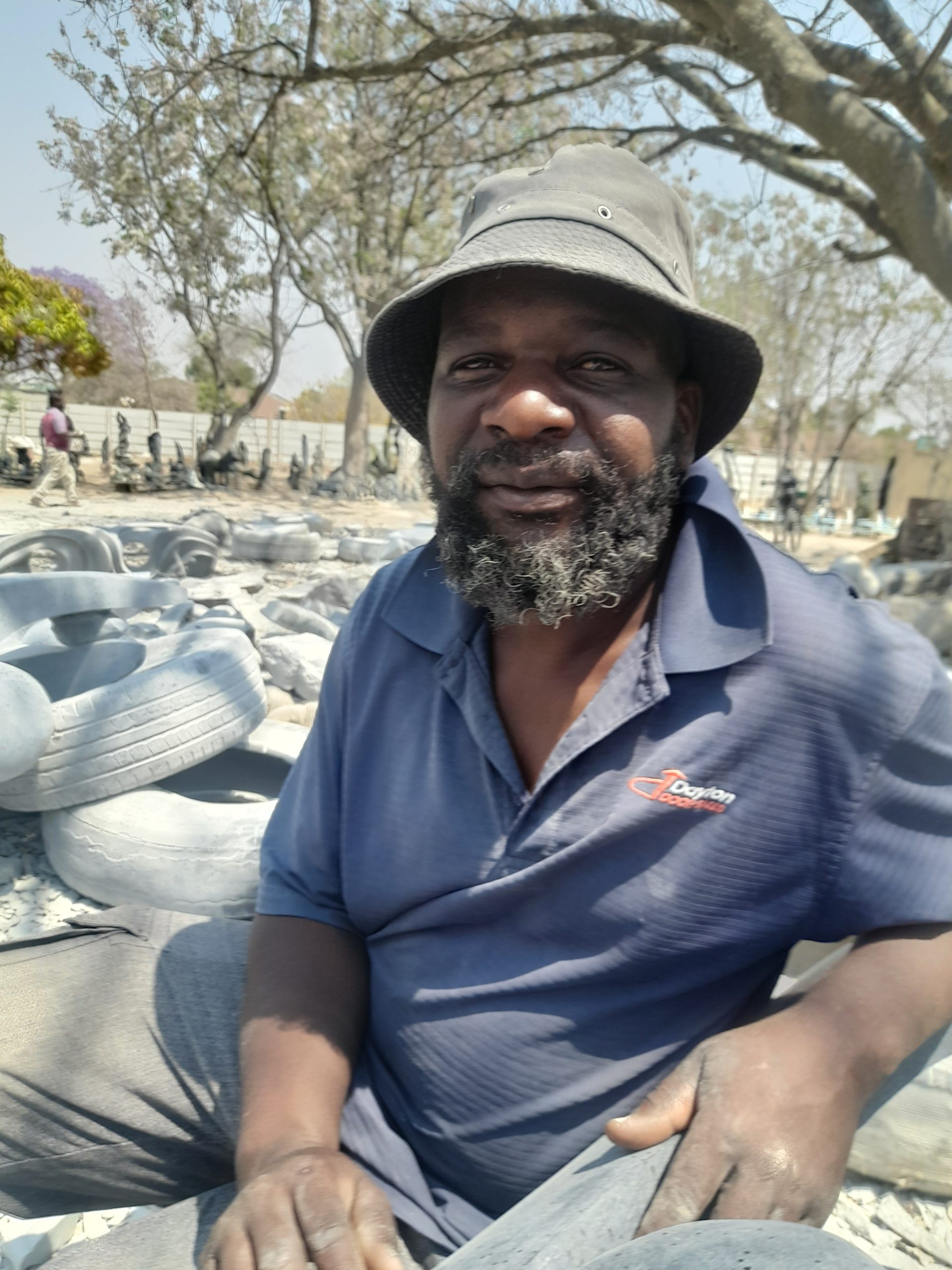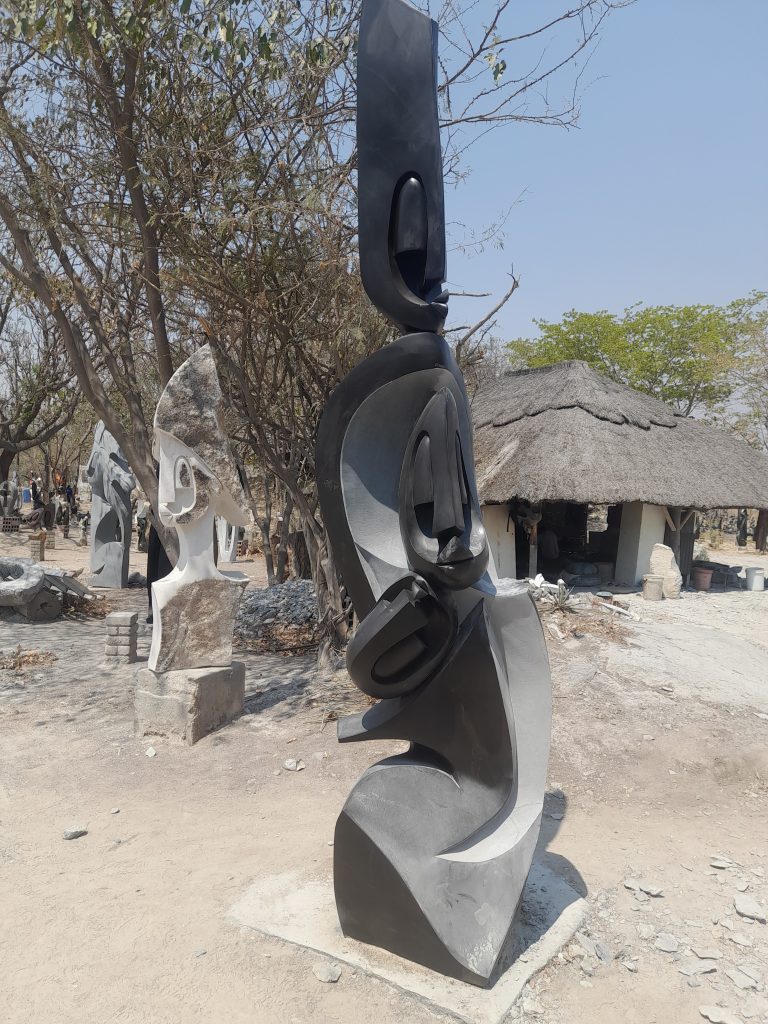
INTERVIEW| Isaac Choloka Breathes the Family Spirit into New Sculpture
I want the family spirit revived because that’s what gives us society. That’s what builds a nation. Everything stands or falls around the health of our family ties – Isaac Choloka, Sculptor at Chitungwiza Arts Centre
By Mukoma Onai | September 2025
ONAI MUSHAVA (OM): Do you start with a picture in your head or a stone in your hand?
ISAAC CHOLOKA (IC): It happens both ways. Sometimes, you have a picture in your head before you get the stone. Sometimes you get the stone, and the stone tells you where to go.
Usually, when you begin with a sculpture in your head and go out to look for the stone, that art may be challenging. Because the stone you get may not break down to form. This is different from just getting a natural rock and creating from there.
OM: Right, Mudhara! But how do you get raw stone to speak to you. Is it the doing of spirit to shape something into existence, to make it exist as if it has always existed, and to make it speak about other existing forms.
IC: Pure talent! There is an older generation of Shona Sculpture which said it dreamed stone. These were founders negotiating the darkness of a previously unknown turf. They are the people who say they dreamed. But this generation we are in, you may dream if that’s who your are, but things are also handed down to you along the line of tradition to improve on.
Many new artists come through training. Sometimes, you take youths off the streets and teach them. And that’s how you get your new masters.
OM: I need to understand that. An artisan is trained. Isn’t an artist necessarily born? Can one come to sculpture the way one comes to engineering, for example?
IC: It is inborn. That’s what I also believe.
OM: So, you take youths off the streets and empower them with the tools. But they will either find their spark in this or not…
IC: You see now! He may actually fail to grasp it. Like a recent group of youths we engaged, some actually failed and surrended. Those who found the spark are still here if you walk around.
OM: This is your social response to widespread unemployment and drug abuse?
IC: You have said it! I have examples of boys I dragged here kicking and screaming. Today they are here, working.
OM: Right! So, Mudhara, we come back to this piece staring down at us with three faces.
IC: Yes?

OM: Which mood sat you down to this new piece?
IC: What was happening with this sculpture, each time someone came along, they saw it in a different way. That’s what you get with abstract. It’s different from traditional Shona Sculpture where you get, say, someone with hands, fingers and so on.
For me, though, I wanted to capture family issues in our time. People must love their families. Those who want marriage must get married and start families. This will give us a better society than what we are getting.
People no longer stay together. Single mothers are on the rise. When the father goes out to look for greener pastures, he goes for good, and does not return to the family.
So I want the family spirit revived because that’s what gives us society. That’s what builds the nation. Everything stands or falls around the health of our family ties.
You can see, this is still a young family, although it is represented in a big sculpture. The child got to be their first child. If you go around our communities, you find young girls with babies on their back. “What age are you?” “17; I am 18.” “Where did you get a child? Where is the father?” You see? It’s something that touches you.
OM: And you chose springstone to channel this message?
IC: That’s the stone. We get springstone from Mvurwi; you also find it in Guruve. When you are working on it, it’s grey like that piece in progress over there.
IC: That’s the natural state.
OM: Yes. We then polish it to get this black color. We also get green stone from Chiweshe, Shamva, Kwekwe and so on.
OM: Do you have other preferred themes besides?
IC: Usually, when I am exhibiting, I work with a given theme. Otherwise, I randomly pick depending on which theme will be moving me at a given time.
I am mostly inspired by our lives in the community. Our joys and sorrows. And also, what we are trying to teach the youths so they may master profitable skills.
OM: Right! What was your own moment of discovery to say, “Look; I am a man of stone”?
IC: Back in high school freestyled anything the teacher want illustrated. Say the map of Zimbabwe, cartoons and so on. I didn’t struggle with those.
So, after finishing school, I was staying in Chegutu by then, there was someone who stayed around, who was really into art. He did cooking sticks, animals and so on. Whenever I saw he, his art took me over a bit by bit.
OM: Off wood, right?
IC: He used wood and soapstone. So, I connected with him and he taught me a little.
OM: So now, you were translating 2D to 3D?
IC: I didn’t translate 2D visions to 3D as such?
OM: It was a startover?
IC: Startover, yes. I had to find a different vision. I need to soak up the scene and appreciate other talents.
OM: Still in Chegutu?
IC: Yes.
OM: So to come to Chitungwiza, it was already the journey of art?
IC: Yes. Chitungwiza was home in a way. But once I was more settled here, I started to appreciate that this is a big home as they say, Mushamukuru. I was coming across a lot of art talent, spending time with them and learning as well as I could.
OM : How old were you then?
IC: 17, 18, 19.
OM : Between then and now, it was now just art.
IC: From my late teens. Now I am 46 and this is all I have lived on. I have never gone job-hunting.
OM: Where do you usually exhibit.
IC: Sometimes here at Chitungwiza Arts Centre; sometimes at National Gallery.
OM: When people talk about Chitungwiza as the arts capital, they are talking about music. Is enough of a light being shone on other art forms, what you are doing here, for example?
IC: What cultural gatekeepers don’t know, in a way, is Chitungwiza is well-established in the global imagination where sculpture is concerned.
If you look at most first-generation sculptors, they came from here. Chitungwiza is heavy with talent; that’s for sure. I was happy to witness talent awards at Aquatic Complex last month. However, we still need to appreciate that art is more than music.
OM: Which visual art legends made Isaac Choloka? Those who came from this place or elsewhere.
IC: Many, many names. Some were taken by time, some we still have them. Lazarus Takawira mentored me the most. We have Nobert Shamhu, Manguwa, Nicholas Mukomberanwa, Albert Mamvura. Too many of them from Chitungwiza.
OM: Big names, really. Was it seeing their work or interacting personally? Those days they carved at home. The center had not yet been erected.
When Chitungwiza Arts Center was opened in 1997, we would line on the roadside like the carpenters are doing nowadays. We had those roadside displays and our international customers knew that if they need sculptures, they had to come over.
OM: Regarding apprenticeship, is art something you assign a student that I want this part to come out this way and still be the creator.
IC: If you look at this new piece, the stone would be massive on arrival. So you can assign someone to say, remove this for me, remove that for me. A student can take two to three days working on those unwanted parts. At the same time, he will be learning and observing.
OM: Thank you for the insights, Mwana waBaba.
IC: Pachedu!
Feedback: mukomaonai@duck.com
